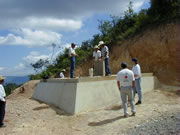- World Water Day 2009 - Shared Waters, Shared Opportunities
- Home Water Treatment - Global household water treatment and safe water storage.
- Cholera - Learn about this life threatening disease.
Global access to safe water, adequate sanitation, and proper hygiene education can reduce illness and death from disease, leading to improved health, poverty reduction, and socio-economic development. However, many countries are challenged to provide these basic necessities to their populations, leaving people at risk for water, sanitation, and hygiene (WASH)-related diseases. CDC programs such as the Safe Water System can empower communities to improve their water by using household treatment options.
Global Water, Sanitation, and Hygiene Topics
Community Systems
Water Safety Plans, Assessment and Development...
Sanitation & Hygiene
Toilets & Latrines, Hygiene, Sewer & Wastewater...
CDC Programs & Projects
Global WASH CDC Programs, Global WASH CDC Projects...
Diseases & Contaminants
Waterborne, Sanitation and Hygiene-related...
Household Treatment
Safe Water System, Safe Storage...
Travelers' Health
Safe Drinking & Recreational Water, Injury & Illness...
Resources & Publications
Websites, Publications...
Global Water Fast Facts
- Worldwide, 884 million people do not have access to an improved water source* (1). Many more obtain their drinking water from improved, but microbiologically unsafe, sources.
- An estimated 2.5 billion people — half of the developing world — lack access to adequate sanitation (more than 35% of the world’s population) (1,2).
- According to the World Health Organization and UNICEF, improved sanitation could save the lives of 1.5 million children per year who would otherwise succumb to diarrheal diseases (1).
- Worldwide, 149 countries and territories are affected by at least one neglected tropical disease (NTD) (3).
- Guinea Worm Disease (GWD) is an extremely painful parasitic infection spread through contaminated drinking water. GWD is characterized by thread-like worms slowly emerging from the human body through blisters. Infection occurs among people living in impoverished communities in remote parts of Africa that do not have safe water to drink. In 2008, fewer than 5,000 cases of Guinea Worm Disease were reported. Most of those cases were from Sudan (78%) (4).
- Worldwide, soil-transmitted helminths infect more than one billion people due to a lack of adequate sanitation (5).
- Trachoma is the world’s leading cause of preventable blindness and results from poor hygiene and sanitation. Approximately 41 million people suffer from active trachoma and nearly 10 million people are visually impaired or irreversibly blind as a result of trachoma (6). Trachoma infection can be prevented through increased facial cleanliness with soap and clean water, and improved sanitation.
Restoring Safe Water and Sanitation

In Latin America and the Caribbean, approximately 125 million persons live without improved sanitation, and 50 million get their drinking water from an unimproved source, according to the World Health Organization and UNICEF. When natural disasters strike, additional lives are threatened.
In 1998, Hurricane Mitch left more than 10,000 Central Americans dead and some 500,000 homeless, due to catastrophic flooding. In an effort to respond to the effects of this event, CDC’s Global Water, Sanitation, and Hygiene team partnered with the American Red Cross to create The Central America Sustainability Project. This project was designed in an attempt to restore safe water and sanitation to communities. This partnership brought sustainable water, sanitation construction, and hygiene education to affected areas, resulting in long-term health benefits.
- Read “Restoring Safe Water and Sanitation: Saving Lives”
 (PDF, 116 kb, 2 pages)
(PDF, 116 kb, 2 pages) - For more information, visit CDC’s Sustainability Research page.
* An improved water source is defined as water that is supplied through a household connection, public standpipe, borehole well, protected dug well, protected spring, or rainwater collection.
- World Health Organization and UNICEF. Progress on Drinking Water and Sanitation – Special Focus on Sanitation. Available at http://www.who.int/water_sanitation_health/monitoring/jmp2008/en/index.html.
- U.S. Census Bureau. International Programs Center: Population Clocks. Available at http://www.census.gov/ipc/www/.
- World Health Organization. Neglected Tropical Diseases, Hidden Successes, Emerging Opportunities. Available at http://whqlibdoc.who.int/hq/2006/WHO_CDS_NTD_2006.2_eng.pdf
 (PDF, 1.39 mb, 52 pages).
(PDF, 1.39 mb, 52 pages). - WHO Collaborating Center for Research, Training, and Eradication of Dracunculiasis. Guinea Worm Wrap-Up #186. Available at http://www.cdc.gov/ncidod/dpd/parasites/dracunculiasis/wrapup/gw186.pdf
 (PDF, 825 kb, 13 pages)
(PDF, 825 kb, 13 pages) - World Health Organization. Soil-Transmitted Helminths. Available at http://www.who.int/intestinal_worms/en/index.html.
- International Trachoma Initiative. What is Trachoma? Available at http://www.trachoma.org/core/sub.php?cat=trachoma&id=trachoma.
- Please note: Some of these publications are available for download only as *.pdf files. These files require Adobe Acrobat Reader in order to be viewed. Please review the information on downloading and using Acrobat Reader software.
Contact Us:
- Centers for Disease Control and Prevention
1600 Clifton Rd
Atlanta, GA 30333 - 800-CDC-INFO
(800-232-4636)
TTY: (888) 232-6348
24 Hours/Every Day - healthywater@cdc.gov



